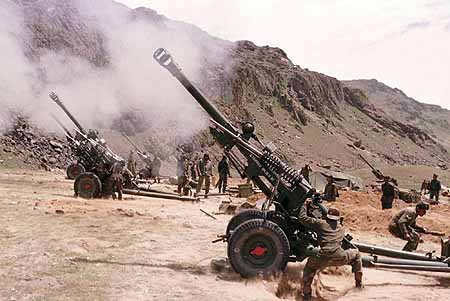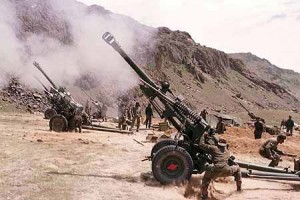Col J P Singh, Retd
‘Kargil Yudh’ was the last armed conflict of the 20th century fought between India and Pakistan from May to July 1999 on the trans Himalayan plateau in Kargil District of J&K. The cause of this war was surreptitious infiltration of Pakistani soldiers on Indian side of the LOC. Pakistan called it ‘Kargil Ki Jung’ whereas Indian Army named it ‘Op Vijay’. During the initial stages of war Pakistan projected the infiltration as ingress by Kashmiri insurgents who were fighting for the independence of J&K. Later revelations by the Prime Minister and the Army Chief of Pakistan confirmed that it was a planned aggression. People all over the world wondered why after half a century of two countries becoming sovereign independent nations continue to fight. To understand why it happened and may continue happening, a brief look into pre Kargil history will clear the confusion.
Before the partition of 1947, Kargil was part of Baltistan District of princely state of Jammu and Kashmir. Indo-Pak War of 1947- 48 bisected Baltistan giving Kargil town and adjoining areas to Indian side. Kargil town lies at the junction of Shingu and Suru Rivers. The genesis of the Kargil conflict lies in Pakistan’s repeated failure to annex J&K. 3 conventional wars, 15 years of fighting in Siachen and 12 years of militancy had led her to exasperation. From 1995 militancy in the valley was on the decline and this was the cause of concern to the Pakistan Army and the ISI. Hence the last war of the century and also the first direct ground war between the barring nuclear powers was forced on India by Pakistan. Kargil episode highlighted Pak deep rooted hostility towards India.
National Highway 1D connects Leh, 205 from Srinagar via Kargil. The area which faced infiltration was 160 Kms long stretch of high mountains overlooking the only road link to Leh. Army posts in Kargil were located at 16 to 18 K ft high peaks which used to be vacated during the winters when the temperature fell to – 30 degrees C and re occupied in summers. It was a routine practice for both armies to abandon some of the posts on their side of the LOC during winters and reduce patrolling of the areas that may be avenues of infiltration. When the weather conditions would improve those positions would be re occupied and patrolling resumed.
Before the beginning of summer in 1999, Pakistan infiltrated their Special Operations Groups and Northern Light Infantry sub units to covertly set up bases on vantage points on the Indian side. According to some reports these sub units were backed by Afghani and Kashmiri mercenaries. Pak intrusions took place in the lower Mushkoh Valley along the Marpo La Ridge near Dras; in Kaksar near Kargil; Batalik sector East of Indus River and Chorbat La where LOC turns North and in the Turtok sector South of Siachen. Pak intrusion in Kargil was first reported by a shepherd on 3 May 1999. On May 5 a patrol was sent to verify it. It was ambushed. 5 soldiers were captured and tortured to death. On 9 May, Pak Artillery shelled ammunition depot at Kargil which caught fire resulting into greater loss of ammunition and panic in the township.
There had been no Indo – Pak war since 1971 except direct confrontation while establishing new military outposts at Siachen. But conducting of nuclear tests by both sides in 1998 had heightened tensions and created a worrying belligerent atmosphere. In an attempt to defuse tensions, Indian Prime Minister Atal Behari Vajpayee took a bus journey to Lahore in February 1999 and signed Lahore Declaration resolving a peaceful solution to contentious issues.
While Indian govt was making peace overtures at diplomatic level, Pak armed forces were covertly infiltrating Pak troops in the guise of Mujahideens to occupy Kargil heights with the aim of severing links between Srinagar and Leh to force Indian Army to withdraw from Siachen glacier thus forcing India to negotiate an agreement on Kashmir dispute. Pakistan also believed that this action will internationalise Kashmir issue helping it to secure a speedy resolution. Yet another aim was to boost the sagging moral of decade long militancy in Kashmir valley by a pro active role. Another aim could be to do Siachen on Indian Kargil.
Analysts believe that the blue print of Kargil War was prepared after Gen Pervez Musharraf was appointed Army Chief in October 1998. Pak Premier Nawaz Sharif conceded that he was kept un informed of Kargil misadventure and he learnt on receiving an alarming telephone call from Indian Premier Vajpayee. Musharraf on the other hand asserted that Sharif had been briefed on the Kargil Operation 15 days ahead of Vajpayee’s visit to Lahore and the blame game continued.
India responded with mobilising its armed forces which responded magnificently to the challenge. Because of the nature of the terrain, basic fighting was conducted mostly at the battalion level. The number of infiltrators has been put at approximately 5,000. Army supported by IAF recaptured most of the positions before Pakistan started withdrawal from illegal occupations. The young officers and men did a splendid job on the ground. It was they who turned the tables in Kargil. 527 brave soldiers laid down their lives for the country. 1363 were disfigured and maimed for the rest of life. It is to the sacrifices of these unsung heroes that this article is dedicated in all humility.
Leh to Srinagar was only two lane road. High altitude affected load carrying ability of aircrafts. Pakistanis carried out direct line of sight artillery fire on the highway, inflicting heavy casualties on the Indians. This was a serious problem for the Army as the highway was its life line. The protection of this route and the recapture of the forward posts remained objective throughout. This resulted in first clearing Tiger Hill and Tololing in Dras, which dominated the Srinagar-Leh route, soon followed by the Batalik-Turtok sub-sector. Some of the peaks that were vital to Pakistanis were Point 4590 and Point 5353; both allowed the Pakistani troops to observe NH 1D. The recapture of Point 4590 by Indian troops on June 14 was significant. Its capture resulted in highest number of casualties in a single battle during the conflict. Pakistan sought American help in de-escalating the conflict. On 15 June President Bill Clinton, in a telephonic conversation with Nawaz Sharif refused to intervene until Pakistan withdrew all infiltrators from the Indian side of the LOC. After gaining control of the hills overlooking the highway, Army turned towards depth positions. Capture of Tololing tilted the combat in India’s favor. Tiger Hill was strongly fortified and offered stiff resistance. In a fierce hand to hand fight 10 Pakistani and 5 Indian soldiers were killed. The Indian Army launched its final attacks in the last week of July. The fighting ceased on 26th July 2012. The day has since been christened as Kargil Vijay Diwas (Kargil Victory Day). By the end of the war, India had regained control of entire area South and East of the LOC as was established in July 1972 as per the Simla Agreement.
Bofor guns played a vital role despite lack of space and depth to deploy them. Aerial attacks were used with limited effectiveness. Mirages used laser-guided bombs to destroy well entrenched Pakistani positions. IAF lost a MiG-27 due to engine failure and one MiG-21 was shot own. One Mi-8 helicopter was also shot with a Stinger missile.
This much is clear that Kargil conflict succeeded in derailing the Lahore peace process. It needed determined statesmanship in both countries to resume dialogue process hereafter. Despite this Premier Vajpayee showed the magnanimity in the overall interest of the nation. Military coup in Pakistan designed to counter attempted civil Coup by Nawaz Sharif was a direct offshoot of Kargil conflict. Benazir Bhutto called the Kargil War “Pakistan’s greatest blunder”. Many ex military and ISI officers believed “Kargil was a waste of time” and “could not have resulted in any advantage” on the larger issue of Kashmir. Lt Gen Ali Kuli Khan Khattak, lambasted the war as “a disaster bigger than the East Pakistan tragedy”.
The end of the Kargil conflict was followed by general elections, which gave a decisive mandate to the caretaker NDA govt. It was re-elected to power in October 1999. On the diplomatic front, Indo-US relations improved as the US appreciated Indian attempts to restrict the conflict to a limited geographic area. Relations with Israel which had discreetly aided India with ordnance supply and material such as unmanned aerial vehicles and laser-guided bombs as well as satellite imagery also bolstered.
Each battle and campaign leaves certain lessons for the posterity and perspectives for future. The Kargil war is no exception. In the last decades a host of military and non military threats have cropped up to our national security. Therefore, in future, country will have to be prepared for conventional war, limited war, proxy war, terrorism, militancy, chemical & biological war as well as nuclear threat.



